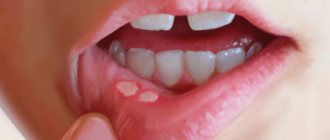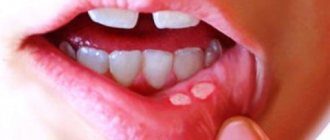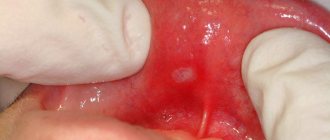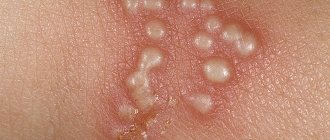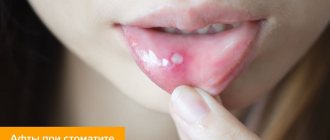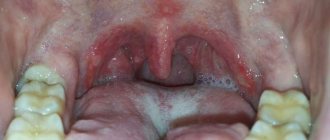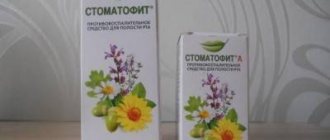Content:
- How do they manifest themselves?
- Where do they come from?
- Consequence of dental diseases
- Aphthae of traumatic nature
- Result of common diseases
- How to cure
Defects of the mucous membranes of the oral cavity are not uncommon.
Many people encounter them. They can occur due to infectious and viral diseases, mechanical damage to tissues. Most often, dentists encounter white sores on the gums. These are painful areas that prevent the patient from enjoying life. They make eating problematic and do not allow for high-quality hygiene measures. Any touch to the affected area provokes acute pain.
It is important not to ignore the presence of white patches on the gums. If they appear, you should contact your dentist. The doctor will determine the cause of the disease and tell you how to eliminate it.
Symptoms
Manifestations of recurrent stomatitis are characterized by the following clinical signs and symptoms:
- At the very beginning of an exacerbation, the mucous membrane of the oral cavity swells, turns pale, the formation of pronounced red spots, as well as hyperemia of certain areas, is possible.
- A limited inflammatory process begins on the mucous membrane, resulting in the formation of an oval or round aphthae, reaching several millimeters in diameter. On top, the inflammation is covered with a grayish coating, difficult to separate from the aphthae. Most often, the inflammatory process occurs on the surface of the mucosa, but it can also penetrate deeper, causing tissue necrosis. In this case, an ulcerative inflammation forms at the site of aphthous inflammation, after healing of which a scar remains on the mucous membrane.
- Damage to the mucous membrane is painful, makes it difficult to eat and is accompanied by copious uncontrolled salivation.
- With each relapse, the cervical and submandibular lymph nodes become painful and increase in size. A slight increase in temperature, weakness, headaches and simultaneous aphthae rashes on the genital mucosa are possible.
- The disease can accompany a person throughout his life. At first, relapses have some kind of sequence, most often occurring in the spring and autumn seasons, but over time the frequency becomes confused, exacerbations occur more often, the periods between them can be shortened from several months to several weeks and even days.
- The duration of an exacerbation depends on the general condition of the body and can take up to ten days for one aphtha to heal. If they do not appear at the same time, then the relapse is prolonged until the last rash heals.
Where do they come from?
Conventionally, all provoking factors can be divided into the following groups:
- mechanical or thermal damage to tissues;
- dental diseases;
- systemic pathologies.
In other words, the problem may be much more serious than it seems at first glance.
Consequence of dental diseases
Among the diseases of the oral cavity that cause the appearance of painful white spots are:
- Aphthous stomatitis. Has a relapsing course. A person develops painful aphthae. They can be located on the cheeks, tongue, palate, lips. They always hurt a lot. Heal within 7-10 days. If such an aphtha is damaged by carelessness, the regeneration processes will proceed very slowly and after the end of regeneration, a non-absorbable scar will remain. Until now, scientists have not established why aphthous structures appear. Most researchers believe that reduced immunity is to blame.
- Herpetic stomatitis. Caused by the herpes virus. A huge number of small white erosions appear in the patient’s mouth. Women over the age of thirty are prone to the disease. Aphthae occur on the tongue and on the surface of the floor of the mouth. They do not have clear boundaries. “They drag on” for one to a week and a half. In addition to ulcers, this form of stomatitis causes increased body temperature, enlarged subcervical lymph nodes, and general weakness.
- Necrotizing periadenitis. Another name for this pathology is Setton's aphthae. The disease is difficult to correct. It often takes several years to treat it. First, compactions appear under the mucous membrane. Soon, instead of them, ulcers with protruding edges form. They can be strewn with the surface of the cheeks, tongue, lips. Setton's aphthae are always very painful. They interfere with normal conversation and eating.
- Vincent's ulcerative necrotic stomatitis. Infectious lesion. It is caused by associations of fusobacteria and spirochetes. Painful areas form in the patient's mouth. The condition is aggravated by muscle pain and headaches. To eliminate tumors in the mouth, doctors carry out local etiotropic therapy, use antibiotics and antiprotozoal drugs. It has been noticed that Vincent's disease is more often encountered by men over the age of thirty with reduced immunity and vitamin deficiency.
Recurrent aphthous stomatitis of the oral cavity
Treatment is effective only with an in-depth clinical and immunological examination of patients, which allows, based on the data obtained, to select the appropriate individual complex pathogenetic therapy. Before starting treatment, the patient should be examined by a therapist, otolaryngologist and other specialists in order to identify concomitant diseases, primarily the gastrointestinal tract, foci of chronic infection, and the state of the immune system. Particular attention should be paid to identifying and treating dental and periodontal diseases.
All these measures make it possible to individualize the process of complex pathogenetic treatment, which includes the use of immunocorrective agents, metabolic correction drugs with mandatory sanitation of foci of chronic infection.
For immunocorrection, thymogen is used, which has a regulatory effect on the reactions of cellular and humoral immunity, as well as on factors of nonspecific resistance of the body. Thymogen is administered intramuscularly at a dose of 100 mcg daily for 10 days, always under the control of an immunogram before and after treatment.
To regulate the mechanisms of specific and nonspecific protection in recurrent aphthous stomatitis, levamisole (Decaris) is also used. The drug is prescribed 2 days a week (in a row or at intervals of 3-4 days, 150 mg at a time or 50 mg 3 times a day). Treatment is carried out for 1.5-2 months under the control of the clinical formula of peripheral blood and the general condition of the patient.
In order to normalize the cellular metabolism of lymphocytes, metabolic drugs are prescribed that stimulate metabolic processes at the mitochondrial level. The selection of drugs and the duration of metabolic therapy are determined by cytochemical indicators of the enzymatic status of blood lymphocytes (activity of mitochondrial sucdinate dehydrogenase, alphaglycerophosphate dehydrogenase). Prescribe 2 complexes of metabolic drugs. The first complex, used for 10 days, is aimed at activating energy processes in lymphocytes: calcium pantothenate (2 ml of a 20% solution intramuscularly or orally, 0.1 g 4 times a day); riboflavin mononucleotide (1 ml of 1% solution intramuscularly); lipamide (0.025 g 3 times a day after meals); cocarboxylase (0.05 g intramuscularly); Potassium orotate (0.5 g 3 times a day 1 hour before meals).
Over the next 10 days, a second set of metabolic drugs is prescribed that are involved in hemoglobin synthesis, regulate lipid synthesis and stabilize cell membranes: vitamin B|2 (1 ml of 0.01% solution intramuscularly); folic acid (0.005 g 3 times a day); pyridoxal phosphate (0.02 g 3 times a day after meals); methylmethionine sulfonium chloride (0.1 g 3 times a day after meals); calcium pangamate (0.05 g 3-4 times a day); phytin (0.25 g 3 times a day); Potassium orotate (0.5 g 3 times a day 1 hour before meals).
The sequence of administration of the complexes is determined by the indicators of cytochemical analysis, but, as a rule, the first complex is introduced first, optimizing the energy potential of immunocompetent cells, then the second, which requires the energy preparedness of the tissues for its utilization.
To achieve stable clinical remission of recurrent aphthous stomatitis, characterized by normalization of the cytochemical status of blood lymphocytes, 4-6 courses of metabolic correction are required at intervals of 6 months, regardless of the characteristics of the clinical course of the disease. It should be especially noted the need for metabolic therapy in the spring, when the symptoms of hypovitaminosis are pronounced, usually leading to severe exacerbations of recurrent aphthous stomatitis.
Complex therapy for recurrent aphthous stomatitis includes sedatives (valerian root, “minor” tranquilizers), glycine.
Particular attention should be paid to measures to eliminate foci of chronic infection, the sanitation of which must be carried out without fail - treatment of chronic periodontal diseases, ENT organs, gastrointestinal tract, etc. Foci of chronic sepsis cause constant bacterial sensitization, which leads to frequent exacerbations of the disease.
In order to stimulate specific and nonspecific protection factors, modern methods of physical influence on the body are effective (transcutaneous electrical neurostimulation, laser therapy on reflexogenic zones, aeroion massage on the affected oral mucosa). In severe cases of the disease, hyperbaric oxygen therapy is used.
A set of therapeutic measures, including immunocorrective, metabolic and reflexology, promotes the rapid elimination of exacerbation of the disease, significantly lengthens the periods of its remission, eliminates cellular and tissue hypoxia and normalizes immunological parameters. A positive therapeutic effect can also be obtained from each of the previously mentioned treatment methods separately, but its effectiveness is less pronounced. Therefore, it is recommended to use these methods for treating recurrent aphthous stomatitis in combination.
Diet plays an important role in successful treatment. Patients are prohibited from eating hot, spicy foods, alcoholic beverages, and smoking.
Local treatment comes down to sanitation of the oral cavity, elimination of traumatic factors and foci of chronic infection. During an exacerbation of the disease, painkillers are prescribed, since aphthae, especially ulcers, cause severe pain. For pain relief, applications of anesthetics are used (1-2% lidocaine solution, 1-2% trimecaine solution, 1-2% pyromecaine solution or 5% pyromecaine ointment), as well as a 10% suspension of anesthesin in glycerin or liquid oils (peach, apricot, sunflower).
The combined effect of medicinal and physiotherapeutic methods of pain relief is effective (microelectrophoresis on the affected area of the oral mucosa with a 2% novocaine solution followed by aeroion massage, laser irradiation).
Fibrinous and necrotic plaque from the surface of afts and ulcers is removed using proteolytic enzymes (trypsin, chymotrypsin, chymopsin, lysoamidase). Antiseptic treatment is carried out with antiseptic solutions (1% etonium solution, 0.02-0.06% chlorhexidine solution, 0.02% furatsilin solution, etc.).
To stimulate epithelization of the affected oral mucosa with recurrent aphthous stomatitis, it is advisable to prescribe an oil solution of vitamins A, E, carotolin, 5% linetol ointment, solcoseryl ointment and jelly, solcoseryl dental adhesive paste, 5% ointment and 20% Actovegin jelly, etc.
Applications and irrigation of the oral mucosa with antiseptic solutions are performed 3-4 times a day after meals. A good therapeutic effect is achieved by the use of biopolymer soluble films containing analgesic and antimicrobial drugs. To stimulate the regeneration of the oral mucosa, a sea buckthorn film containing sea buckthorn oil is successfully used.
The prognosis is favorable, especially in the case of early diagnosis and treatment of its mild form.
Aphthae of traumatic nature
Ulcers resulting from trauma include:
- Afty Bednar. Happens only to small children. They are traumatic ulcerations. They arise due to the habit of constantly gnawing hard objects, poor hygiene, and gross mechanical irritation of the upper palate. Usually such white areas are covered with a yellowish coating, which can be easily removed.
- Traumatic aphthae. These include ulcers formed due to sudden movements with a toothbrush, carelessly performed dental treatment, rubbing of dentures, exposure to acids, alkalis, and medications. Treatment of such neoplasms does not take much time and is not complicated. The main thing here is to remove the influence of the provoking factor, then the tissues will recover fairly quickly.
Result of common diseases
Some diseases have a systemic effect on the body. This means:
- Tuberculosis. When the lungs are affected, negative symptoms can spread to the mucous membranes of the mouth. This occurs due to the penetration of the pathogen into the oral cavity through damaged epithelium. Then the patient develops ulcers on the cheeks and under the tongue. First, these are always specific tuberculous tubercles, and then aphthae. They grow quite quickly. At the same time, an increase in the amount of plaque on the tongue, weakness, and loss of body weight are recorded.
- Syphilis. Pathology caused by Treponema pallidum. During the incubation period, which lasts about three weeks, aphthae occur. They are round or oval. Their edges are usually raised, swollen, and the color is red. Such damage takes a long time to heal - up to three months. Syphilis erosions are not as painful as tuberculosis ones. After their healing, retracted scars form.
- HIV infection. It has been noticed that every third HIV-infected person has inflamed oral tissues. In this case, therapy must be specific. It is not the dentist who is responsible for its implementation, but the infectious disease specialist. As soon as the patient’s health improves and the immune system is strengthened, the aphthae will disappear on its own.
What it is
This type of stomatitis manifests itself in the form of chronic inflammation of the mucous membrane and soft tissues of the oral cavity with periodic exacerbations, characterized by the abundant formation of long-term non-healing aphthae, erosions and ulcers. Exacerbations of recurrent stomatitis can be caused by the condition of the body, the seasonality of allergic reactions, changes in hormonal levels and other reasons.
Most often, this disease occurs in adults and in children from the age of four who previously suffered an acute form of aphthous stomatitis, which turned into a chronic condition. It is difficult to find any pattern in the frequency of relapses, since, over many years, exacerbations of chronic recurrent stomatitis can occur unsystematically and unpredictably.
The so-called habitual aphthosis or recurrent aphthous stomatitis can occur without any changes in the body except for the appearance of inflammation. The aphthae themselves form chaotically, each time in a new place. They can appear separately or side by side, merging into one large erosion, around which noticeable redness forms.
How to cure
Treatment for damage to the mucous membranes is always selected individually. There is no single regimen that is suitable for every clinical situation. First, the doctor determines the cause of the complication, and only then tells how it can be eliminated. The emphasis is on the area of the affected surface and the features of its localization, the presence of concomitant diseases, and the severity of symptoms.
To stimulate local regenerative processes the following can be used:
- topical agents - gels, solutions, creams, ointments;
- medications administered orally, intravenously or intramuscularly (broad-spectrum antibiotics, painkillers, immunostimulants, anti-inflammatory drugs, vitamins);
- physiotherapy.
In some cases, it is necessary to carry out professional hygiene, treat identified dental diseases, and replace old prosthetic systems with new ones. If necrotic tissue needs to be removed, the doctor uses anesthetics. They make the intervention painless.
It is very important that a person does not ignore painful areas on the gums. If they appear and do not go away within three to five days, you should definitely consult a dentist. After all, it is possible that the disorder is not associated with stomatitis, but with some serious pathology of the internal organs. In any case, you won’t be able to find out at home.
Of course, it is easier to prevent the development of a dental disorder than to treat it. Preventive measures to prevent the occurrence of erosion on the gums come down to following the rules of hygiene, undergoing specialized dental examinations, timely treatment of all diseases, and proper nutrition. People who care about their health encounter gum ulcers much less frequently.
Prevention
It is almost impossible to determine the causes of chronic aphthous stomatitis, however, there are ways to prevent the development of relapses if certain conditions are met:
- it is necessary to adhere to a strict diet that excludes possible allergens, as well as spicy, too salty, too spicy and rough foods;
- in the house where the patient lives, wet cleaning is required as often as possible;
- all foci of chronic infections must be eliminated;
- Personal hygiene for such a patient should be an integral part of life. Visiting the dentist is recommended once every 3-4 months; in addition, it is useful to use medicinal products to care for the oral cavity and gums;
- It is necessary to give up bad habits that injure soft tissues and oral mucosa.

